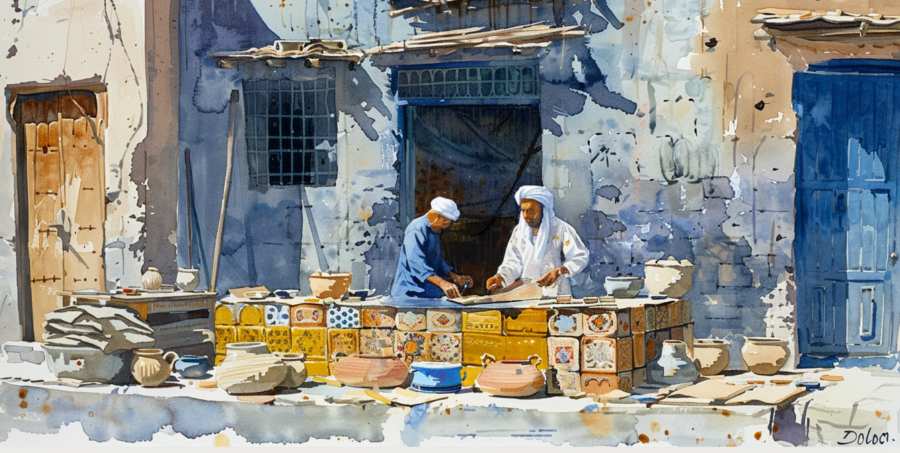Zellij Masters of Fez: A Jigsaw Puzzle for the Extremely Patient
Fez is famous for its zellij, the stunning geometric tilework that decorates mosques, palaces, and fancy riads. What most people don’t see is the backbreaking labor that goes into making it. Inside hidden workshops, artisans sit for hours, chiseling tiny ceramic pieces by hand. The process is a mix of art and math—a miscalculation, and suddenly, a tile that was meant to be part of a grand design is just a very decorative paperweight.A private guide can take you behind the scenes to meet these craftsmen, who might let you try your hand at chiseling a tile yourself. Spoiler alert: You will be terrible at it. But they will smile politely and pretend your misshapen attempt has potential.
Berber Carpet Weaving in the Atlas Mountains: Slow Fashion, Literally
Up in the Atlas Mountains, far from the chaotic energy of Marrakech, Berber women sit at looms, weaving intricate patterns into carpets that can take months to complete. Unlike the quick negotiations of the souks, time moves differently here. There’s no rush, no pressure—just the steady rhythm of weaving, the soft hum of conversation, and possibly a chicken wandering through the room as if it owns the place.Visiting these family-run workshops is an experience in patience and precision. You’ll see how natural dyes are made from saffron, pomegranate skins, and indigo, and how every design tells a story—though decoding it without guidance is like trying to read a book in a language you don’t speak. This is where a private guide proves invaluable, translating not just the language, but the deeper cultural significance of each pattern.
Metalworking in Marrakech: Where Sparks Fly (Literally)
Tucked away in Marrakech’s labyrinthine alleys, metalworkers hammer away at brass, copper, and silver, creating ornate lanterns, trays, and teapots. The sound is rhythmic, almost musical—if your idea of music involves a lot of banging.A private guide can lead you to workshops where artisans cut, etch, and solder metal with impressive precision. If you’re lucky, you might witness the creation of a filigree lantern, where delicate patterns are punched into sheets of brass. One slip of the hand, and that lantern becomes a very expensive colander.
These workshops are not on the average tourist’s itinerary, partly because they are well-hidden and partly because, let’s be honest, most people are distracted by the nearby food stalls selling sizzling skewers of meat. But with the right guide, you’ll get to see how these metal creations go from raw sheets to gleaming works of art—and perhaps even commission a custom piece. Just don’t expect an IKEA-level price tag.
Leather Tanning in Fez: Not for the Faint of Nose
If you’ve ever bought a Moroccan leather bag or a pair of beautifully handcrafted slippers, congratulations—you now own something that was once soaked in pigeon poop. Yes, the tanneries of Fez still use a centuries-old process that involves natural dyes, elbow grease, and an aromatic cocktail that has been known to make unsuspecting tourists gag.Most visitors view the tanneries from a safe (and less pungent) balcony, but with a private guide, you can venture into the workshops where workers stand knee-deep in dye pits, massaging leather with a focus that suggests they’ve long since stopped noticing the smell. They’ll explain how different skins—camel, cow, goat—are treated and dyed using poppy flowers for red, saffron for yellow, and indigo for deep blues.
Pro tip: Guides often hand out sprigs of mint to help mask the scent. Use them. If you’re feeling brave, tuck them directly into your nostrils.
Woodworking in Essaouira: Where Sawdust Becomes Souvenirs
Essaouira, with its salty ocean breeze and laid-back vibe, is home to some of Morocco’s most skilled woodworkers. While tourists browse the markets, real craftsmanship is happening in tucked-away workshops where artisans carve thuya wood into intricate boxes, chess sets, and furniture that smells as good as it looks.A private guide can get you into workshops where the tools have barely changed over generations. You’ll watch as artisans shape wood with precision, inlaying it with lemonwood and mother-of-pearl to create pieces so beautiful, you’ll suddenly wonder why your coffee table at home looks like a soulless slab of MDF.
Of course, if you show too much admiration, don’t be surprised if an artisan offers to sell you a massive hand-carved cabinet. Explaining that you only have carry-on luggage might not get you off the hook—Moroccans are excellent problem solvers.
Pottery in Safi: Not Just for Show
Safi is Morocco’s pottery capital, but unless you have a guide, it’s easy to end up in one of the many tourist-oriented shops instead of the real deal—workshops where potters sit at foot-powered wheels, molding clay with practiced hands. Watching them work is mesmerizing; one moment, it’s a lump of earth, the next, it’s a perfectly symmetrical bowl. It looks so easy, right up until they let you try it.A good guide will introduce you to artisans who still use traditional kilns, and if you’re lucky, you might even be allowed to shape a piece of pottery yourself. Be warned: what starts as a hopeful attempt at a sleek vase might end up looking like a deformed mug. But hey, it’s your deformed mug.
Parting with Handmade Treasures (and Possibly Your Luggage Space)
By the time your private guide has taken you through Morocco’s hidden artisan workshops, you’ll have a newfound appreciation for handmade goods—and possibly an overweight suitcase. There’s something special about owning an object when you’ve met the person who made it, seen the process, and maybe even failed at attempting it yourself.So if you find yourself leaving Morocco with a handwoven carpet, a brass lantern, a suspiciously wobbly piece of pottery, and a leather bag that smells slightly of pigeon-related history, you’re doing it right. Just remember: every dent, stitch, and chisel mark tells a story—one you wouldn’t have found if you’d stuck to the souks.
Article kindly provided by adrartravel.com
